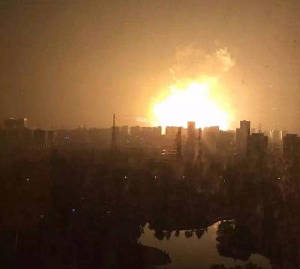Explosions of Tianjin, a disaster of unprecedented scale
 Explosion of Tianjin © Eristic, CC BY-SA 4.0 Explosion of Tianjin © Eristic, CC BY-SA 4.0 |
Located 120 kilometers from Beijing, Tianjin Port, the fourth largest in terms of cargo volume (540 million tons of cargo is trans-shipped every year through it) and tenth in terms of container traffic, was on August 12, 2015, the scene of two spectacular explosions. A fire broke out in a warehouse illegally storing thousands of tons of hazardous and flammable materials, causing one of the largest disasters ever reported in China.
Human and environmental toll
According to the final official toll, dated 14 September 2015, the explosions have claimed the lives of 173 people, including 104 firefighters, while the number of people injured stood at 700. In addition, the evacuation of residential areas around the damaged sites required the displacement of more than 6 000 people.
In addition to the human loss, this incident has had serious consequences on the environment. Highly toxic chemicals, including sodium cyanide were dejected in the air. Approximately 700 tons of these dangerous ingredients were stored in a warehouse when the disaster struck.
A few days after the accident, high levels of cyanide, up to 356 times higher than the tolerance level, were recorded in several water points near the site.
Heavy economic repercussions due to ultra-concentration of risks
Given the extent of the disaster area which is spread over a radius of four kilometers, damage assessment will be long and complicated. According to the bureau of expertise, "International Surveyors and Adjusters', the operation is even more difficult now that the registrar of the port where the cargo records were located was completely destroyed by the flames.
The port city of Tianjin is not only an entrance and exit door for imports and exports for the first largest economy in the world, but it is also home to oil refineries and advanced-technology companies housed in the heart of its industrial zone. It also has a large peripheral residential area.
According to authorities, 17 000 homes were totally or partially damaged, 1 700 companies affected, and 10 000 new cars stored in the port consumed by fire. In addition to material damage, (property, cargo and infrastructure), the disaster caused significant operating losses: suspension of the transit of certain goods, production stoppage, interruption of the supply chain and disruption in world trade.
The logistical circuits of several multinational companies were also overwhelmed or paralyzed. It is worth reminding that out of the largest 500 multinationals that are operational worldwide, nearly 150 are conducting their business in Tianjin. For instance, the Toyota plant in Tianjin, located on the outskirts of the city, has been out of business for two weeks after the production units of its subcontractors, also installed in the disaster area, came to a halt.
This assembly site, the second in order of importance in China, manufactures 430 000 vehicles per year, that is half of the production of the Japanese manufacturer in the Middle Kingdom. For the automotive sector alone, Chinese authorities estimated losses at around 310 million USD.
Insurance will pay the heaviest price
Because of the concentration of risks in one area, this technical catastrophe is considered to be one of the most costly ever reported in China.
The amount of losses to the charge of insurers will be not only high but also difficult to assess given the large number of companies and people affected by the event.
An initial estimate prepared by Credit Suisse, has referred to losses comprised between 1 and 1.5 billion USD. In early September, this first assessment was revised upwards by the American broker Guy Carpenter forecasting that the toll will range between 1.6 and 3.3 billion USD, just for the coverage of damages related to buildings, cargo and containers.
The International Union of Marine Insurance), on its part, estimates that the final bill could amount to 6 billion USD, 1.5 billion USD of which would be dedicated to compensation for marine cargo insurance. The Union considers that the explosion of Tianjin, the largest loss ever reported in marine cargo, will significantly impact marine insurance results in 2015.